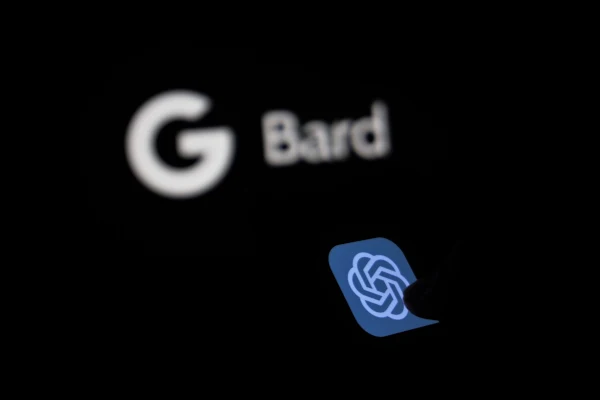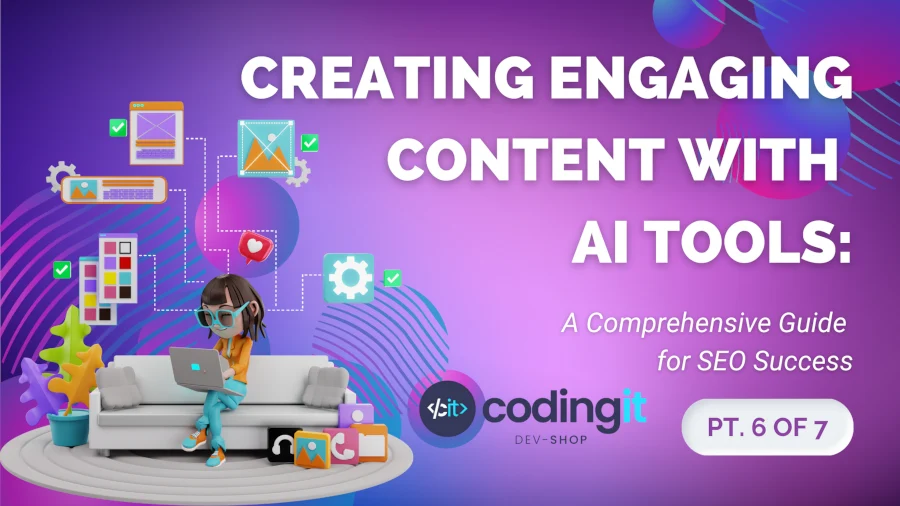Content creation has emerged as a pivotal element in the success of marketing and branding efforts. However, with the ever-increasing competition for online visibility, businesses must find ways to stand out amidst the noise and connect with their audience on a deeper level. This is where the power of artificial intelligence (AI) comes into play.
AI has revolutionized numerous industries, and content creation is no exception. By leveraging AI tools, businesses can unlock a world of possibilities, enabling them to create compelling, relevant, and SEO-friendly content that resonates with their audience. This article is designed to equip you with the knowledge and skills to harness the immense potential of AI in content creation.
By following the comprehensive guidance provided in this series of articles, this is only part 6 of the 7 part series, you will gain a deeper understanding of AI-powered content creation and its immense potential for driving organic traffic and user engagement. Equipped with practical knowledge and valuable insights, you will be empowered to leverage AI tools to create compelling and optimized content that sets you apart in the hyper-competitive digital landscape.
Now, let’s begin exploring the world of AI-powered content creation and unlocking the opportunities it holds!
- Analyzing and Optimizing AI-Generated Content
Analyzing and Optimizing AI-Generated Content
To ensure the success of your AI-generated content, it is essential to collect and analyze performance metrics, leverage AI analytics tools for insights, identify areas of improvement, and monitor content engagement. In this chapter, we will delve into these key aspects of analyzing and optimizing AI-generated content to maximize its effectiveness and impact.
Collecting and Analyzing Performance Metrics
Collecting and analyzing performance metrics is crucial for evaluating the effectiveness of your AI-generated content and understanding its impact on your audience. Here are some key metrics to consider:
Click-through rate (CTR)
Measure the percentage of users who click on your AI-generated content. A higher CTR indicates that your content is compelling and enticing enough to drive user engagement.
Conversion rate
Determine the percentage of users who take a desired action after interacting with your AI-generated content, such as making a purchase or filling out a form. A higher conversion rate indicates that your content is effectively driving desired user behaviors.
Time on page
Assess how long users spend on a page with AI-generated content. A longer average time on page suggests that your content is engaging and holding users’ attention.
Bounce rate
Evaluate the percentage of users who leave your website or page after viewing the AI-generated content without further engagement. A lower bounce rate indicates that your content is relevant and engaging enough to keep users on your site.
Example:
Suppose you have an AI-powered chatbot on your website that interacts with users and provides support. By tracking metrics like the chatbot’s response rate, resolution time, and customer satisfaction ratings, you can assess its performance and identify areas for improvement.

Monitoring and Measuring Content Engagement
Monitoring and measuring content engagement is essential to understand how users interact with your AI-generated content. Here are some ways to effectively monitor and measure engagement:
Heatmap analysis
Use AI tools to generate heatmaps that visualize user interactions with your AI-generated content. This helps to identify areas of high engagement and areas that may require improvement or optimization. After all, don’t fix what isn’t broken, spend the time making the weak points of your platform stronger.
Social media analytics
Monitor social media platforms to track user engagement metrics such as likes, comments, shares, and mentions related to your AI-generated content. This not only provides insights into its reach and impact, but if your audience is evening using one platform over another, informing you where to invest the time, energy, and budget.
Conversion tracking
Implement conversion tracking tools to measure how your AI-generated content contributes to desired user actions, such as purchases, sign-ups, or downloads. As we stated earlier on in this series, everything we do must have data to back it up. Have conversion goals that are aligned with our own goals to ensure our work is going in the desired direction.
Continuous Improvement and Adaptation
Optimizing AI-generated content is not a one-time task but an ongoing process. To ensure long-term success, businesses must embrace the mindset of continuous improvement. This means regularly monitoring performance metrics, analyzing user feedback, and adapting content strategies accordingly. In the ever-changing digital landscape, staying agile and responsive to changes is the key to staying ahead of the curve. So, let’s buckle up and commit to the path of continuous improvement!
Balancing Automation with Human Touch
AI-generated content has incredible potential, but it’s crucial to strike the right balance between automation and human involvement. While AI algorithms can create compelling content, incorporating human input adds authenticity, empathy, and alignment with your brand’s values. Don’t forget that your content represents your business, and human touches, such as creative input and thoughtful review, can elevate it to new heights. Let’s harness the power of AI while keeping the human touch intact!
Contextual Understanding
While metrics are essential, they don’t always tell the whole story. To gain a deeper understanding, we must consider the broader context surrounding our data. In addition to analyzing performance metrics and user behavior, it’s crucial to take industry benchmarks, seasonal variations, and external factors into account. By placing our data in context, we can unlock hidden insights and make more informed decisions. Let’s zoom out and view the bigger picture!

Continuous Improvement and Adaptation
Optimizing AI-generated content is an ongoing journey of growth and evolution. To stay ahead of the game, it’s crucial to embrace continuous improvement and adaptation. This means that your efforts shouldn’t stop after implementing your AI-generated content strategy. Instead, you should proactively monitor its performance, seek user feedback, and be open to making necessary adjustments to your content strategies.
Regularly monitoring performance metrics allows you to gain insights into how well your AI-generated content is resonating with your audience. By analyzing metrics such as click-through rate, conversion rate, time on page, and bounce rate, you can identify areas that need improvement and areas where you’re excelling. This valuable data empowers you to refine your content, optimize its effectiveness, and deliver more impactful experiences to your audience.
In addition to performance metrics, analyzing user feedback is equally important. Actively seeking feedback and paying attention to user suggestions, preferences, and pain points enables you to gain a deeper understanding of your audience’s needs and desires. By incorporating this feedback into your content optimization process, you can refine your AI-generated content to better address user requirements and enhance their overall experience.
Adapting your content strategies is crucial in the ever-changing digital landscape. User preferences and expectations are constantly evolving, and it’s essential to remain agile and responsive to these changes. By keeping a finger on the pulse of industry trends, emerging technologies, and evolving user behaviors, you can adapt your AI-generated content to meet the evolving needs of your audience. This adaptability allows you to maintain relevance and provide content that captures their attention and drives desired user behaviors.
Balancing Automation with Human Touch
While AI-generated content is incredibly powerful and efficient, it’s essential to strike a balance between automation and human involvement. AI algorithms can create compelling and personalized content, but incorporating the human touch adds a layer of authenticity, empathy, and alignment with your brand’s values.
Human input plays a crucial role in the content creation and review processes. It allows you to infuse your brand’s unique voice and perspective into the AI-generated content. Through creative input, human writers, designers, and editors can ensure that the content reflects the essence of your brand, resonates with your target audience, and conveys the desired emotions and messages.
Moreover, the human touch brings empathy and understanding to your content. It enables you to address the nuances of human experiences, emotions, and cultural context. By involving human reviewers, you can ensure that the AI-generated content is empathetic, inclusive, and avoids any unintentional biases or insensitive language.
Remember that your content represents your business and brand identity. The human touch adds a personal connection that fosters trust, strengthens relationships, and distinguishes your content from generic automated messages. By striking the right balance between automation and human involvement, you create a winning combination that engages your audience on a deeper level and builds long-lasting connections.

Contextual Understanding
Metrics provide valuable insights into the performance of your AI-generated content, but they should always be considered within the broader context. Contextual understanding allows you to gain a comprehensive and holistic view of your data, enabling you to make well-informed decisions.
To develop contextual understanding, consider industry benchmarks and standards. By comparing your metrics to those of your industry peers, you can identify areas where you excel or areas that require improvement. This industry context provides a benchmark against which you can measure your progress and set realistic goals for your AI-generated content.
Seasonal variations also play a role in shaping user behavior and content performance. Take into account factors like holidays, cultural events, or peak seasons for your business. Adjusting your content strategies to align with these seasonal variations can help you tailor your AI-generated content to meet the specific needs and expectations of your audience during different times of the year.
Additionally, external factors can influence user behavior and the performance of your AI-generated content. Stay aware of market trends, technological advancements, and societal shifts that may impact how users engage with content. By considering these external factors, you can adapt your content strategies and ensure that your AI-generated content remains relevant and resonates with your target audience.
In summary, a contextual understanding of your data provides valuable insights beyond raw metrics. By considering industry benchmarks, seasonal variations, and external factors, you gain a more nuanced understanding of your AI-generated content’s performance and can make well-informed decisions to optimize its effectiveness and impact.
Identifying Areas of Improvement and Optimizing AI Content
Identifying areas of improvement is crucial for optimizing your AI-generated content and enhancing its effectiveness. Here are some strategies to consider:
- Content relevance: Continuously assess whether your AI-generated content aligns with user intent and addresses their needs. Refine and optimize the content to ensure it remains relevant and valuable.
- A/B testing: Conduct A/B tests to compare different variations of AI-generated content. This allows you to identify which versions perform better and make data-backed decisions to improve content effectiveness.
- User feedback: Actively seek and analyze user feedback to gain insights into their preferences, pain points, and suggestions. Incorporate this feedback to refine and optimize your AI-generated content.
An Example would be:
A social media platform that utilizes AI algorithms to generate personalized content recommendations for its users. By regularly analyzing user engagement metrics, conducting A/B tests, and considering user feedback, the platform identifies areas where content recommendations can be improved, leading to increased user satisfaction and engagement.
Conclusion
In the ever-evolving digital landscape, optimizing AI-generated content is a continuous process that requires adaptation and improvement. By embracing continuous improvement and adaptation, businesses can stay ahead of the game and deliver more impactful experiences to their audience.
Regularly monitoring performance metrics and analyzing user feedback are essential components of this process. Metrics such as click-through rate, conversion rate, time on page, and bounce rate provide valuable insights into content effectiveness and user engagement. By leveraging this data, businesses can identify areas that need improvement and make data-driven decisions to enhance their AI-generated content.
Balancing automation with the human touch is another crucial aspect to consider. While AI algorithms can create compelling content, incorporating human input adds authenticity, empathy, and alignment with the brand’s values. This human touch ensures that the content resonates with the audience on a deeper level and builds long-lasting connections.
Contextual understanding is key to gaining a comprehensive view of the data. By considering industry benchmarks, seasonal variations, and external factors, businesses can unlock hidden insights and make well-informed decisions. This broader perspective enables them to optimize their AI-generated content for maximum effectiveness and impact.
As we conclude this series on analyzing and optimizing AI-generated content, it’s important to note that there are still common challenges and pitfalls to address. In the final part of this series, we will delve into these challenges and provide strategies to overcome them. So, stay tuned for Part 7: “Addressing Common Challenges and Pitfalls” to further enhance your understanding and mastery of AI-generated content optimization.
